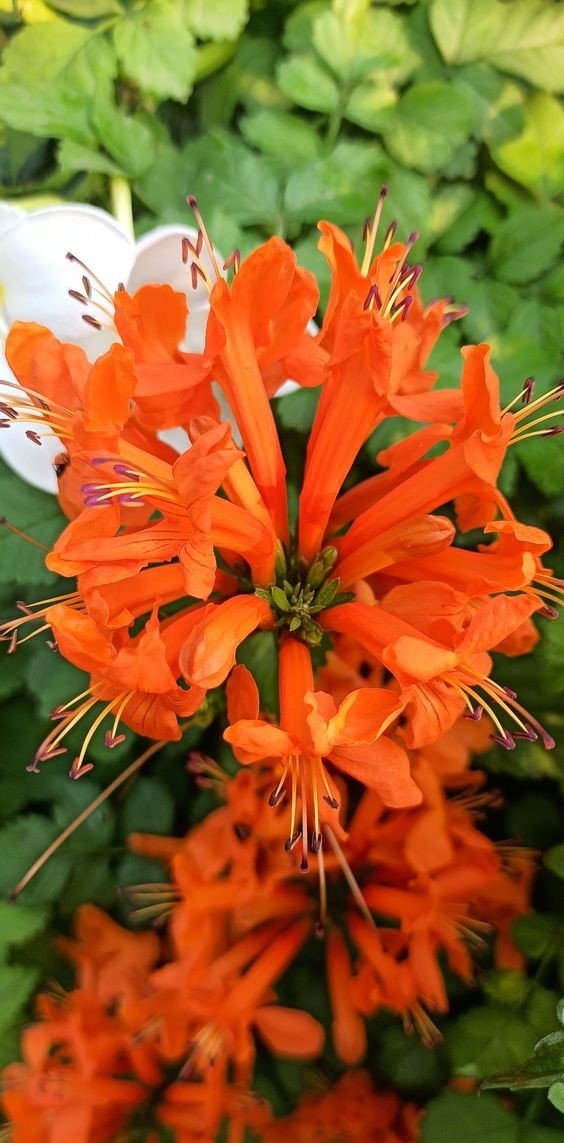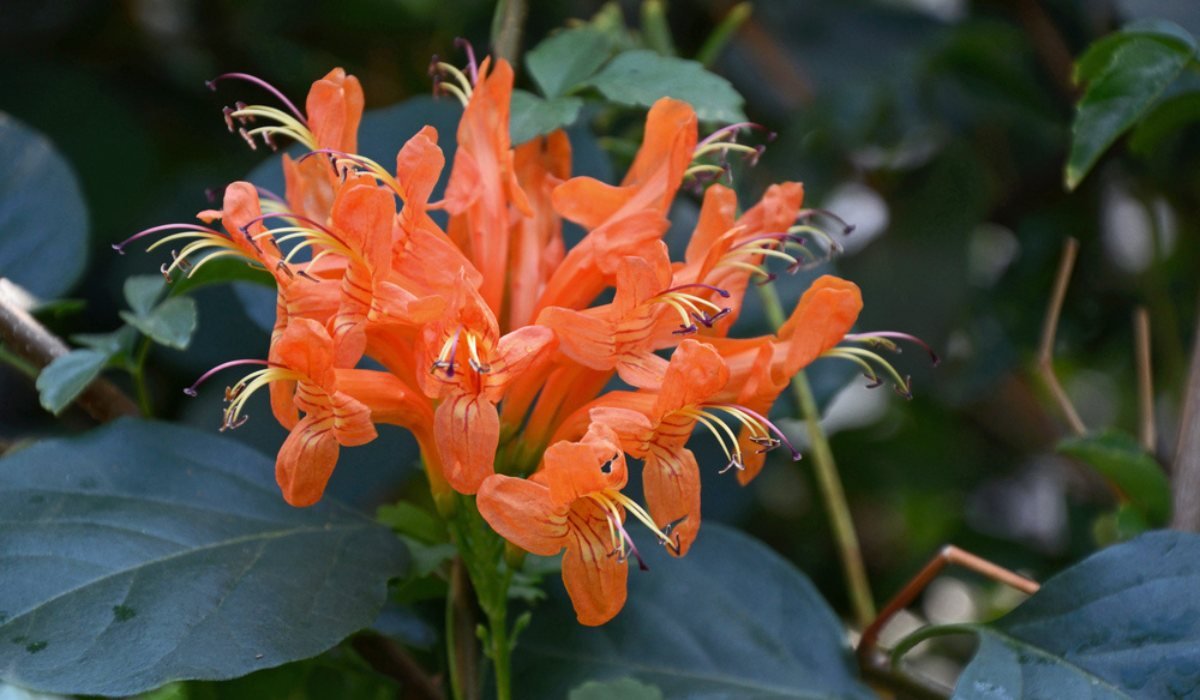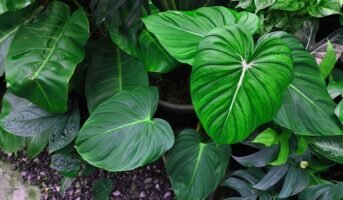Tecoma capensis, commonly known as Cape honeysuckle, is a colourful garden plant that is frequently used for screening and accents. It can be pruned to create a hedge as well. It is frequently planted with the intention of luring butterflies and birds.
In warm climates, Tecomaria capensis is an evergreen plant, but it loses its leaves in cooler climates.
see also: Everything that you need to know about potted plants

Source: Pinterest
Tecoma capensis: Key facts
| Common name | Cape honeysuckle |
| Bloom time | Summer |
| Height Range | 2-22′ (0.6-6.7m) |
| Plant light | Full Sun |
| Height | 3m |
| Common Name | Cape honeysuckle |
| Soil | Water drenched soil |
Tecoma capensis: Physical features
The scrambling, fast-growing Cape honeysuckle can reach heights of 2-3 metres and a width of more than 2.5 metres. It has pinnately compound leaves with oval, blunt-toothed leaflets. This shrub’s flowering season is quite unpredictable, and it frequently blooms all year long. The colours of flowers range from crimson to salmon to deep orange. Flowers that are tubular and pollinated by birds draw nectar-eating birds, particularly sunbirds.
Tecoma capensis: Is it an indoor plant?
Yes, it can be grown both indoors and outdoors. It can be planted anywhere from partial shade to full sun. It can be grown in mildly temperate regions with the shelter of a heated wall because it can withstand temperatures as low as 5 °C (41 °F). If not, it can be cultivated in a container and brought indoors throughout the winter. However, some of the plants might be poisonous to pets, so you need to take care of that if you’re planning to grow this plant.
Tecoma capensis: Growing tips
- To give plants the best start, plant in the spring or the early fall.
- Choose a location that will allow the branches and roots to grow naturally. Plants should be placed far enough away from walls, decks, and building foundations to avoid crowding the structure with growing foliage. Consider whether any tall trees or shrubs nearby could interfere with electrical lines, the roof, or block windows.
- To prepare the planting site, dig a hole three times the size and depth of the root ball. After you’ve removed the soil, mix it with some compost or peat moss. New roots can easily spread by improving the soil and aerating the existing soil.
- To loosen the plant before removing it from the container, gently support its base while tipping it sideways and touching the pot’s exterior. Rotate the container and keep tapping to release the soil until the plant easily emerges from the pot.
- Place the plant in the hole. If the root ball is covered in burlap, the burlap cloth, as well as any strings or wire holding it in place, must now be removed. Gently rake apart densely packed roots with your fingers.
- Soil should be neatly stacked around the root ball in the planting area.

Source: Pinterest
Tecoma capensis: Maintenance
Watering instructions
Young plants require weekly irrigation during their first growing season, depending on rainfall. Deep watering encourages roots to grow deeper into the soil, strengthening the plant and increasing its drought resistance. Dig a tiny hole in the ground with a hand trowel or your finger and feel the soil for wetness. If the top 2-4 inches of soil are dry, it is time to water. Keep an eye on young plants for the first two years to ensure they’re getting enough moisture.
Fertilisation of Tecoma capensis
Mature trees should be nourished every two to three years. Feed plants when they begin to grow in the early spring. Fertilisers come in a variety of forms, including granulated, slow-release, liquid feeds, organic, and synthetic. Determine which application technique is best for the situation, then select a product designed for trees and shrubs or a nutritionally sound, all-purpose composition like 10-10-10. Always follow the instructions on the fertiliser package for application rates and timing. Plant damage can occur as a result of over-fertilising plants or applying fertiliser at the incorrect time of year.
Caring for Tecoma Capensis
Here is a step by step care guide on caring and maintaining the Tecoma Capensis plant.
Light
The needs adequate sunlight. As it is a tropical plant, it thrives in full sunlight. It can also be kept in partial shade, especially in hot climates. The flowering is less vigorous if the shade is denser.
Watering
Water up to one inch of the soil if the plant is kept in full sunlight. Watering is required only once or twice in a month if grown in shade. As years go by, with regular watering, the roots begin to establish themselves and makes the plant drought tolerant.
Humidity and Temperature
The plant cape honeysuckle is resistant to heat and drought. However, its branches prone to damage and can die if exposed to temperatures under 25 degrees Fahrenheit (minus 3 degrees Celsius).
Repotting
Tecoma capensis is an excellent plant to be grown in containers. Make sure to select pots with sufficient drainage holes. Fill them standard potting mix. Remember to choose a container bigger by two inches every time you plan to repot the plant. You can bring potted plant inside during colder season to protect the plant.
Propagation
Tecoma capensis can form suckers or upright stems due to which the plant will propagate naturally. However, if you plant to grow the plant in your home garden, you can propagate it by softwood cuttings.
Here’s how to propagate Tecoma capensis through suckers:
- Wait till a sucker has rooted and you find a new growth. Now, clip the stem connected to the plant, dig it up, and place it in the garden.
- Burying the off-shoot stems during the spring will help this process. Once the new growth is established, around fall, just cut the stem connected to the main plant, dig it and place in the garden.
Here’s how to propagate Tecoma capensis through softwood cuttings:
- Clip off a five-inch-long softwood stems using clean and sharp pruners.
- Trim off all leaves except a few around the top.
- If the base is woody, scrape off portion of the bark using shears.
- To promote growth, dip the base of the cutting in rooting hormone.
- Now, place the cutting in a flowerpot by adding a standard potting mix, preferably mix peat and perlite.
- Make sure the cuttings are moist and maintained at a temperature of 70 to75 degrees Fahrenheit. Cover the pot with a plastic bag to allow it to retain moisture.
- Keep the cuttings exposed to normal daylight. The roots will be established in two to 14 weeks, when you can transplant them to your yard or garden.
Here’s how to propagate Tecoma capensis through seeds:
The plant can be grown from seeds collected from dried bean-like pods left by faded flowers. Plant the seeds in shallow containers. Cover the seeds properly with sand or seed-starting mix. They will germinate in six to 21 days. You can plant the seedlings after strong roots are developed.
Speed of growth
A common problem with Tecoma capensis is that it can be difficult to control its growth with regular pruning. Rampant growth of the plant is seen during in warm and wet climates. One effective way to control it is by withholding water.
Height / spread
You can train the plan into a vine and allow it to grow up a trellis or a jute rope. Regularly trim the upward-growing stems and allow it spread horizontally, to use as ground cover. It can grow up to a height of around two to three feet.
Tecoma Capensis Flowering Season
Growth expectations
Tecoma Capensis is a fast-growing plant. You can grow it in a container to keep it at a manageable size.
Best companion plants for Tecoma Capensis in the garden
A few examples of companion plants for Tecoma Capensis includes Ornamental Grass, Salvia and Yew.
Best locations to plant Tecoma Capensis
The Tecoma Capensis plant grows well in salty locations such as coastal regions and tropical regions. Make sure to keep the plant in an area with maximum sunlight. This helps in flowering.
Best times to plant Tecoma Capensis
The time around spring or early fall is ideal to plant Tecoma Capensis.
Common pests and plant problems
Tecoma Capensis or Cape honeysuckle plant can attract insects and pests, such as aphids and scale insects. When growing the plants indoors, spider mites and whiteflies can also pose problems. Use insecticidal soap to keep away the pests and protect the plant.
Tecoma capensis: Uses
- This lovely garden plant is a popular garden shrub that is frequently planted to attract butterflies to the garden. It is also commonly used as a hedge, both sophisticated (clipped) and informal (unclipped). Farmers also plant it or encourage its growth along fences to provide extra grazing for livestock.
- The bark is used in traditional medicine to treat pain and insomnia, fevers and chest ailments such as bronchitis, stomach pains, diarrhoea and dysentery, and to encourage the flow of dairy in nursing mothers. Diarrhoea and gastroenteritis are also treated with the leaves. To treat bleeding gums, powdered and dried bark is rubbed around the teeth.
FAQs
What is the bark used for?
This lovely garden plant's powdered bark is used in traditional medicine to treat pain and insomnia.
Is pruning necessary for Tecoma capensis?
To eliminate dead branches, stimulate bushier growth, encourage more flowers, or maintain a particular size or shape, pruning may be necessary.
(with inputs from Harini Balasubramanian)
Housing News Desk is the news desk of leading online real estate portal, Housing.com. Housing News Desk focuses on a variety of topics such as real estate laws, taxes, current news, property trends, home loans, rentals, décor, green homes, home improvement, etc. The main objective of the news desk, is to cover the real estate sector from the perspective of providing information that is useful to the end-user.
Facebook: https://www.facebook.com/housing.com/
Twitter: https://twitter.com/Housing
Email: [email protected]











